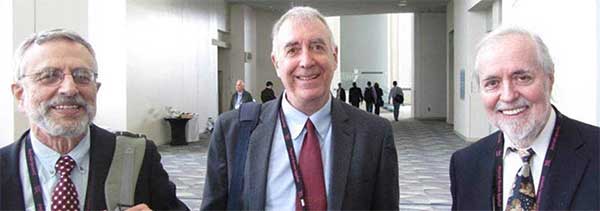Journeys in the History of Physics: The 2014 Pais Prize Session
by David C. Cassidy

PAIS PRIZE SESSION: Daniel M. Siegel, David C. Cassidy, and Brian Schwartz
The 2014 recipient of the Abraham Pais Prize for History of Physics was David C. Cassidy. Joining Cassidy in the Pais Prize session, chaired by Catherine Westfall, were two of Cassidy’s colleagues who have played significant roles in his career. They were Daniel M. Siegel, his dissertation advisor at the University of Wisconsin-Madison, and Brian Schwartz who, in recent years, encouraged and facilitated his development of the play Farm Hall.
In his presentation on “Physics, History and Biography,” Cassidy discussed his journey across the frontiers separating each of these fields. Cassidy crossed into history while a graduate student in physics and, with Daniel Siegel’s advice and guidance, completed his dissertation on “Werner Heisenberg and the Crisis in Quantum Theory, 1920-1925.” Cassidy noted that history is not only about what happened in the past but also about why it happened and what it means. Because of this, history provides a richer understanding of the content of physics, along with a fuller appreciation of the role of physics and physicists in our broader culture and society. Cassidy did not at first intend to write a biography of Heisenberg, but it soon became the logical next step Although scientific biography has its limitations as a historical tool, Cassidy learned from the classics of literary biography that scientific biography must put the science and the life at the center of the scientific and cultural life of the subject’s era. Only in that way can it illuminate why things happened as they did, and how we might learn from those who confronted important issues and decisions in the past as we confront the difficult issues of our own time.
Crossing, most recently, from science history into the arts with the help of Brian Schwartz, Cassidy discovered that, as he imagined his characters coming alive on stage, he gained valuable new insights into their motivations and behavior at the dawn of the nuclear age. Daniel M. Siegel directed the audience’s attention “Toward a Rethinking of the Relativity Revolution,” based upon his forthcoming book Sneaking up on Einstein: The Relativity Revolution, Step by Step.
Siegel’s proposed rethinking would have a profound effect on how we understand the relativity revolution and how we teach the special theory of relativity. In contrast with the traditional view of that revolution as a sudden, discontinuous transition precipitated by Einstein’s relativity paper of 1905, Siegel argued that, historically, key aspects of special relativity theory should be seen rather as undergoing a gradual transition through two stages extending over a 50-year period from the early 1880s to the early 1930 – much, he suggested, like a two-stage rocket.
The first stage, up to 1905, which Siegel called the protorelativistic phase, involved initial treatments of length contraction, mass increase, and invariance properties. The second stage, the Einsteinian phase, involved a recasting of the theoretical framework of prerelativistic electrodynamics, which led to the inclusion of time dilation, the mass-energy relation and continuing competition with results from the protorelativistic phase, all concluding in the triumph of Einstein’s special theory of relativity by the early 1930s.
Siegel argued further that a proper appreciation of the role of the protorelativistic phase in the relativity revolution provides students with a more concrete approach to understanding relativistic effects. It also provides historians with a new perspective on the roles of continuity and gradualism in seemingly discontinuous scientific changes. Finally it demonstrates the significance of the broader scientific community in even the most individual accomplishments.
Brian Schwartz provided an interesting “Insider’s History of Some of the Significant Changes inthe APS from the 1960s to Today.” Schwartz joined the APS in the 1960s, a period of heated discussions about the role of physics in society fueled by the role of science in the unpopular Vietnam War and the severe overproduction and unemployment of physics PhDs.
At that time the APS governance and meeting structure offered no means to address these and related issues, including education, diversity, communications, international issues, and government policies.
Schwartz was one of the original petitioners for structural change. This led to the forum structure, including the Forum (initially proposed as a Division) on Physics and Society (1969) as well as the Committee on the Status of Women in Physics (1972), the Panel on Public Affairs (1975), and many other APS committees and forums.
The Forum on the History of Physics was founded in 1981, also initially as a division. To his surprise, Schwartz was elected to APS governance in 1972. In 1987 Harry Lustig appointed Schwartz APS Education Officer and consultant to MIT on education initiatives. This began a 20-year employment with the APS, during which he ultimately became Associate Executive Officer.
Schwartz recounted his experiences during those years as director of the APS Centennial celebrated in 1999, the controversial move of APS headquarters from New York to College Park, and the establishment of APS News. Since 2005 Schwartz has again taken an active role, this time as the organizer of well-received conferences on Copenhagen and Dr. Atomic, cosponsored by APS, and as the producer of science-based plays at APS meetings and in the New York area.
The articles in this issue represent the views of their authors and are not necessarily those of the Forum or APS.
